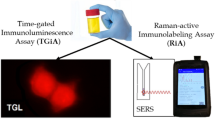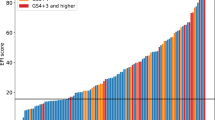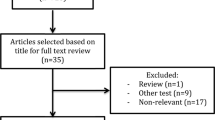Abstract
Background
In the current study, we explore the feasibility of detecting exfoliated prostate cancer cells in urine using an RNA in situ hybridization (RISH) assay. We hypothesized that robust and specific labeling of prostate cancer cells could be achieved in post-digital rectal examination (DRE) urine samples using RISH.
Methods
We focused on method development, optimization, and analytical evaluation of RISH-based detection of prostate cancer in urine. We optimized a sample collection, processing, and target detection workflow for urine cytology specimens in conjunction with RNA target detection by RISH. We screened a panel of 11 prostate-specific RNA targets, and selected NKX3-1 and PRAC1 as markers for cells of prostate origin and PCA3 as a marker of prostate malignancy. Following analytical validation of a multiplexed NKX3-1/PRAC1/PCA3 assay, we evaluated whether prostate cancer cells can be detected in a pilot cohort of 19 post-DRE specimens obtained from men diagnosed with prostate cancer.
Results
Using cytology specimens prepared from spiked urine samples, we established the analytical validity of the RISH assay for detection and visualization of prostate cells in urine. Cells of prostate origin could be readily and specifically identified and separated into benign and malignant cell populations based on the multiplex test that consisted of markers specific for prostate cells (NKX3-1, PRAC1) and prostate cancer cells (PCA3). Upon evaluation of post-DRE urine from a pilot cohort of prostate cancer patients, we identified 11 samples in which prostate cells were present, 6 of which were also positive for prostate cancer cells.
Conclusions
Multiplex RISH enables the direct visualization and molecular characterization of individual exfoliated prostate cells in urine. This proof-of-principle study provides evidence supporting the application of RISH as a potential noninvasive tool for prostate cancer detection.
This is a preview of subscription content, access via your institution
Access options
Subscribe to this journal
Receive 4 print issues and online access
$259.00 per year
only $64.75 per issue
Buy this article
- Purchase on Springer Link
- Instant access to full article PDF
Prices may be subject to local taxes which are calculated during checkout




Similar content being viewed by others
References
Eskra JN, Rabizadeh D, Pavlovich CP, Catalona WJ, Luo J. Approaches to urinary detection of prostate cancer. Prostate Cancer Prostatic Dis. 2019;22:362–81.
Tosoian JJ, Ross AE, Sokoll LJ, Partin AW, Pavlovich CP. Urinary biomarkers for prostate cancer. Urol Clin North Am. 2016;43:17–38.
Rupp M, O’Hara B, McCullough L, Saxena S, Olchiewski J. Prostatic carcinoma cells in urine specimens. Cytopathology. 1994;5:164–70.
Scott WW, Huggins C. The acid phosphatase activity of human urine, an index of prostatic secretion. Endocrinology. 1942;30:107–12.
Breul J, Pickl U, Hartung R. Prostate-specific antigen in urine. Eur Urol. 1994;26:18–21.
Hessels D, Klein Gunnewiek JM, van Oort I, Karthaus HF, van Leenders GJ, van Balken B, et al. DD3(PCA3)-based molecular urine analysis for the diagnosis of prostate cancer. Eur Urol. 2003;44:8–15. discussion 15-16
Hessels D, Schalken JA. The use of PCA3 in the diagnosis of prostate cancer. Nat Rev Urol. 2009;6:255.
Papanicolaou GN, Marshall VF. Urine sediment smears as a diagnostic procedure in cancers of the urinary tract. Science. 1945;101:519–20.
Sharifi R, Shaw M, Ray V, Rhee H, Nagubadi S, Guinan P. Evaluation of cytologic techniques for diagnosis of prostate cancer. Urology. 1983;21:417–20.
Fujita K, Pavlovich CP, Netto GJ, Konishi Y, Isaacs WB, Ali S, et al. Specific detection of prostate cancer cells in urine by multiplex immunofluorescence cytology. Hum Pathol. 2009;40:924–33.
Varma VA, Fekete PS, Franks MJ, Walther MM. Cytologic features of prostatic adenocarcinoma in urine: a clinicopathologic and immunocytochemical study. Diagn Cytopathol. 1988;4:300–5.
Nickens KP, Ali A, Scoggin T, Tan SH, Ravindranath L, McLeod DG, et al. Prostate cancer marker panel with single cell sensitivity in urine. Prostate. 2015;75:969–75.
Zhu Y, Sharp A, Anderson CM, Silberstein JL, Taylor M, Lu C, et al. Novel junction-specific and quantifiable in situ detection of AR-V7 and its clinical correlates in metastatic castration-resistant prostate cancer. Eur Urol. 2018;73:727–35.
Levsky JM, Singer RH. Fluorescence in situ hybridization: past, present and future. J Cell Sci. 2003;116:2833–8.
D’Amico AV, Whittington R, Malkowicz S, Schultz D, Blank K, Broderick GA, et al. Biochemical outcome after radical prostatectomy, external beam radiation therapy, or interstitial radiation therapy for clinically localized prostate cancer. JAMA. 1998;280:969–74.
Epstein JI, Walsh PC, Carmichael M, Brendler CB. Pathologic and clinical findings to predict tumor extent of nonpalpable (stage T1c) prostate cancer. JAMA. 1994;271:368–74.
Brennen WN, Zhang B, Kulac I, Kisteman LN, Antony L, Wang H, et al. Mesenchymal stem cell infiltration during neoplastic transformation of the human prostate. Oncotarget. 2017;8:46710–27.
Erben L, He MX, Laeremans A, Park E, Buonanno A. A novel ultrasensitive in situ hybridization approach to detect short sequences and splice variants with cellular resolution. Mol Neurobiol. 2018;55:6169–81.
McQuin C, Goodman A, Chernyshev V, Kamentsky L, Cimini BA, Karhohs KW, et al. CellProfiler 3.0: Next-generation image processing for biology. PLOS Biol. 2018;16:e2005970.
Bussemakers MJ, van Bokhoven A, Verhaegh GW, Smit FP, Karthaus HF, Schalken JA, et al. DD3: a new prostate-specific gene, highly overexpressed in prostate cancer. Cancer Res. 1999;59:5975–9.
Gurel B, Ali TZ, Montgomery EA, Begum S, Hicks J, Goggins M, et al. NKX3.1 as a marker of prostatic origin in metastatic tumors. Am J Surg Pathol. 2010;34:1097–105.
van der Toom EE, Axelrod HD, de la Rosette JJ, de Reijke TM, Pienta KJ, Valkenburg KC. Prostate-specific markers to identify rare prostate cancer cells in liquid biopsies. Nat Rev Urol. 2019;16:7–22.
Liu XF, Olsson P, Wolfgang CD, Bera TK, Duray P, Lee B, et al. PRAC: A novel small nuclear protein that is specifically expressed in human prostate and colon. Prostate. 2001;47:125–31.
Day JR, Jost M, Reynolds MA, Groskopf J, Rittenhouse H. PCA3: from basic molecular science to the clinical lab. Cancer Lett. 2011;301:1–6.
Laxman B, Morris DS, Yu J, Siddiqui J, Cao J, Mehra R, et al. A first-generation multiplex biomarker analysis of urine for the early detection of prostate cancer. Cancer Res. 2008;68:645–9.
Tomlins SA, Day JR, Lonigro RJ, Hovelson DH, Siddiqui J, Kunju LP, et al. Urine TMPRSS2:ERG plus PCA3 for individualized prostate cancer risk assessment. Eur Urol. 2016;70:45–53.
Hendriks RJ, Dijkstra S, Jannink SA, Steffens MG, van Oort IM, Mulders PFA, et al. Comparative analysis of prostate cancer specific biomarkers PCA3 and ERG in whole urine, urinary sediments and exosomes. Clin Chem Lab Med. 2016;54:483.
Sweat SD, Pacelli A, Murphy GP, Bostwick DG. Prostate-specific membrane antigen expression is greatest in prostate adenocarcinoma and lymph node metastases. Urology. 1998;52:637–40.
Croce AC, Bottiroli G. Autofluorescence spectroscopy and imaging: a tool for biomedical research and diagnosis. Eur J Histochem. 2014;58:2461–2461.
Wang F, Flanagan J, Su N, Wang LC, Bui S, Nielson A, et al. RNAscope: a novel in situ RNA analysis platform for formalin-fixed, paraffin-embedded tissues. J Mol Diagn. 2012;14:22–29.
Deras IL, Aubin SM, Blase A, Day JR, Koo S, Partin AW, et al. PCA3: a molecular urine assay for predicting prostate biopsy outcome. J Urol. 2008;179:1587–92.
Marks LS, Fradet Y, Deras IL, Blase A, Mathis J, Aubin SM, et al. PCA3 molecular urine assay for prostate cancer in men undergoing repeat biopsy. Urology. 2007;69:532–5.
Groskopf J, Aubin SMJ, Deras IL, Blase A, Bodrug S, Clark C, et al. APTIMA PCA3 molecular urine test: development of a method to aid in the diagnosis of prostate cancer. Clin Chem. 2006;52:1089–95.
Alshalalfa M, Verhaegh GW, Gibb EA, Santiago-Jimenez M, Erho N, Jordan J, et al. Low PCA3 expression is a marker of poor differentiation in localized prostate tumors: exploratory analysis from 12,076 patients. Oncotarget. 2017;8:50804–13.
Wei JT, Feng Z, Partin AW, Brown E, Thompson I, Sokoll L, et al. Can urinary PCA3 supplement PSA in the early detection of prostate cancer? J Clin Oncol. 2014;32:4066–72.
Author information
Authors and Affiliations
Corresponding author
Ethics declarations
Conflict of interest
The Johns Hopkins University has filed a patent application in which 4 co-authors were listed as inventors (JNE, WBI, CPP, JL).
Additional information
Publisher’s note Springer Nature remains neutral with regard to jurisdictional claims in published maps and institutional affiliations.
Supplementary information
Rights and permissions
About this article
Cite this article
Eskra, J.N., Rabizadeh, D., Mangold, L. et al. A novel method for detection of exfoliated prostate cancer cells in urine by RNA in situ hybridization. Prostate Cancer Prostatic Dis 24, 220–232 (2021). https://doi.org/10.1038/s41391-020-00272-6
Received:
Revised:
Accepted:
Published:
Issue Date:
DOI: https://doi.org/10.1038/s41391-020-00272-6



